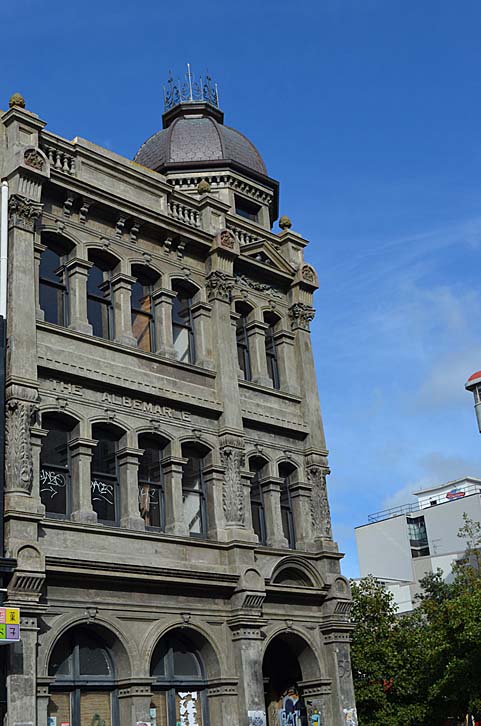The Albemarle Hotel at 59 Ghuznee Street, Wellington, opened in 1906 as a private hotel with 31 ‘fine lofty rooms’. Its distinctive Italianate style exterior with octagonal tower and cupola was designed by prolific Wellington architect James Bennie (1873-1945) and has been described as ‘eclectic’ and ‘exuberant’. It is an important contributor to the Edwardian streetscape of the Cuba Street area and has particular historical and social significance through its association with the 1913 strike movement, notorious boarding house owner Clara Hallam and Wellington’s ‘red light district’, and retains much of its original fabric. The early twentieth century was a time of growth and prosperity in Wellington. New buildings were quickly being erected in the central city - James Bennie himself designed over 200 of them. Private hotels offered short- and long-term accommodation and dining but were not licensed to sell alcohol. While the Albemarle does not appear to have advertised itself specifically as a ‘temperance hotel’, it was undoubtedly affected by the temperance movement which saw alcohol as a major contributing factor to poverty, violence, ill health and immorality. Temperance aimed to reduce the impact of alcohol through voluntary abstinence and legal restrictions. Between 1893 and 1911, New Zealanders could vote to reduce the number of liquor licenses granted in their area or remove licenses altogether, making it very difficult to open a new licensed hotel. The Albemarle was a three-storey building with rendered brick walls, timber exterior joinery, corrugated iron roofing and a striking octagonal rooftop tower capped with a cupola. While the ground-floor street front was relatively plain with Doric columns either side of two arched windows and an arched entryway, the street front exterior of the second and third floors was more richly decorated with foliated Corinthian columns on the first floor, plain columns topped by ornate Corinthian capitals on the second floor and a balustrade and ornate parapet at roof level. Apart from an additional partial fourth floor added later in 1906, the structure of the building has remained unchanged. A second-floor wrought iron balcony that had served as a street-level verandah was removed and at one point the cupola was also removed, before being replicated and reinstated in 2007. The Albemarle became the unofficial headquarters of the 1913 Wellington waterfront strike movement, hosting most of the out-of-town strike leaders, including future Prime Minister Peter Fraser. The hotel was later run as a boarding house by ‘loveable rogue’ Clara Hallam, who was known for accepting homeless alcoholics at her boarding houses and renting rooms by the hour. It spent some years as massage parlour before being left unoccupied from the 1990s. Various repairs and attempts to revive the fortunes of the building have occurred since the gentrification of the area in the 1990s, but these have not yet (2019) resulted in the building being reopened.


Location
List Entry Information
Overview
Detailed List Entry
Status
Listed
List Entry Status
Historic Place Category 2
Access
Private/No Public Access
List Number
3633
Date Entered
6th June 1984
Date of Effect
6th June 1984
City/District Council
Wellington City
Region
Wellington Region
Extent of List Entry
Extent includes the land described as Pt Sec 152 Town of Wellington (RT WN20C/845), Wellington Land District and the building known as Albemarle Hotel thereon.
Legal description
Pt Sec 152 Town of Wellington (RT WN20C/845), Wellington Land District
Stay up to date with Heritage this month
